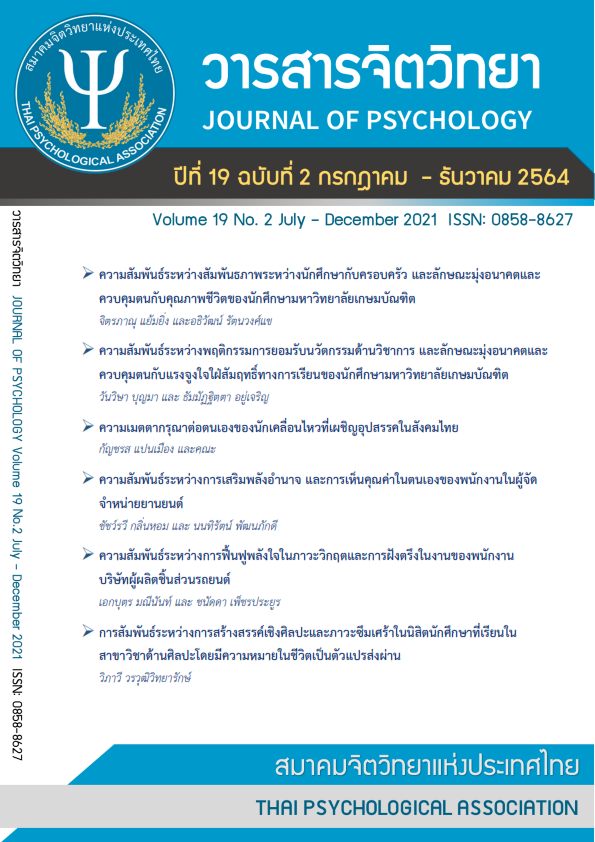Relationships between Artistic Creativity and Depression of Art Undergraduate Students with Meaning in Life as a Mediator
Keywords:
Artistic creativity, Meaning in life, Depression, Art studentsAbstract
This study aimed to examine relationships between artistic creativity and depression of art undergraduates with meaning in life as a mediator. Participants were 311 art undergraduate students with mean age of 20.53 years old. Instruments were the Thai version of The Epstein Creativity Competencies Inventory for Individuals, Purpose in Life Test, and Depression Subscale of 42 Depression Anxiety Stress Scale. Testing moderating effect is based on the approach of Baron & Kenny (1986). The result revealed that meaning in life was fully mediating the relationship between the artistic creativity and depression of art undergraduates. This finding indicated that art students with artistic creativity and high meaning in life are less likely to have less depressive symptoms.
References
อรัญญา ตุ้ยคำภีร์. (2544). การพัฒนามาตรวัดความมุ่งหวังในชีวิตนักศึกษาไทย. วารสารสุขภาพจิตแห่งประเทศไทย, 9(1), 18-26.
อรัญญา ตุ้ยคำภีร์. (2554). จิตบำบัดแนวความหมายในชีวิต Logotherapy (พิมพ์ครั้งที่ 2). โรงพิมพ์แห่งจุฬาลงกรณ์มหาวิทยาลัย.
Baron, R. M., & Kenny, D. A. (1986). The moderator–mediator variable distinction in social psychological research: Conceptual, strategic, and
statistical considerations. Journal of Personality and Social Psychology, 51(6), 1173-1182.
Blackburn, L., & Owens, G. P. (2015). The effect of self efficacy and meaning in life on posttraumatic stress disorder and depression severity
among veterans. Journal of Clinical Psychology, 71(3), 219-228.
Crumbaugh, J. C., & Maholick, L. T. (1964). An experimental study in existentialism: The psychometric approach to Frankl's concept of noogenic
neurosis. Journal of Clinical Psychology, 20(2), 200-207.
Epstein, R. (1996). Capturing creativity. Psychology Today, 29(4), 41-43.
Epstein, R., & Phan, V. (2012). Which competencies are most important for creative expression?. Creativity Research Journal, 24(4), 278-282.
Epstein, R., Schmidt, S. M., & Warfel, R. (2008). Measuring and training creativity competencies: Validation of a new test. Creativity Research
Journal, 20(1), 7-12.
Feist, G. J. (1998). A meta-analysis of personality in scientific and artistic creativity. Personality and Social Psychology Review, 2(4), 290-309.
Frankl, V. E. (1963). Man's search for meaning: An introduction to logotherapy. Pocket.
Guilford, J. P. (1967). The nature of human intelligence. McGraw-Hill.
Jamison, K. R. (1989). Mood disorders and patterns of creativity in British writers and artists. Psychiatry, 52(2), 125-134.
Kang, K., Im, J., Kim, H., Kim, S., Song, M., & Sim, S. (2009). The effect of logotherapy on the suffering, finding meaning, and spiritual well-being
of adolescents with terminal cancer. Journal of Current Directions in Psychological Science, 312-319.
Kersting, K. (2003). What exactly is creativity. Monitor on Psychology, 34(10), 1-40.
Lovibond, S. H., & Lovibond, P. F. (1995). Manual for the Depression Anxiety Stress Scales (2nd ed.). Psychology Foundation.
MacKinnon, D. W. (1962). The nature and nurture of creative talent. American Psychologist, 17, 484–495.
Phillips, W. M. (1980). Purpose in life, depression, and locus of control. Journal of Clinical Psychology, 36(3), 661-667.
Silvia, P. J., & Kimbrel, N. A. (2010). A dimensional analysis of creativity and mental illness: Do anxiety and depression symptoms predict
creative cognition, creative accomplishments, and creative self-concepts?. Psychology of Aesthetics, Creativity, and the Arts, 4(1), 2-10.
Sternberg, R. J. (2006). The nature of creativity. Creativity Research Journal, 18(1), 87-98.
Torrance, E. P. (1988). The nature of creativity as manifest in its testing. The nature of creativity, 43-75.
Waddell, C. (1998). Creativity and mental illness: is there a link?. The Canadian Journal of Psychiatry, 43(2), 166-172.
Published
How to Cite
Issue
Section
License
Copyright (c) 2021 Thai Psychological Association

This work is licensed under a Creative Commons Attribution-NonCommercial-NoDerivatives 4.0 International License.
บทความที่ได้รับการตีพิมพ์เป็นลิขสิทธิ์ของสมาคมจิตวิทยาแห่งประเทศไทย
ข้อความที่ปรากฎในบทความแต่ละเรื่องในวารสารวิชาการเล่มนี้เป็นความคิดเห็นส่วนตัวของผู้เขียนแต่ละท่านไม่เกี่ยวข้องกับสมาคมจิตวิทยาแห่งประเทศไทย แต่อย่างใด ความรับผิดชอบองค์ประกอบทั้งหมดของบทความแต่ละเรื่องเป็นของผู้เขียนแต่ละท่าน หากมีความผิดพลาดใด ๆ ผู้เขียนแต่ละท่านจะรับผิดชอบบทความของตนเองแต่ผู้เดียว





